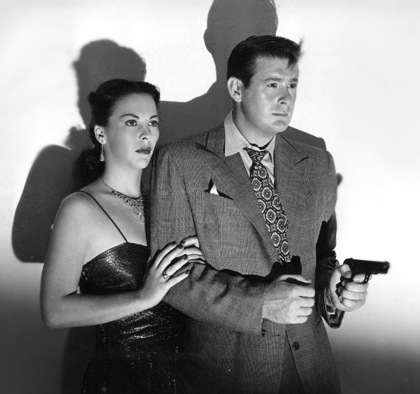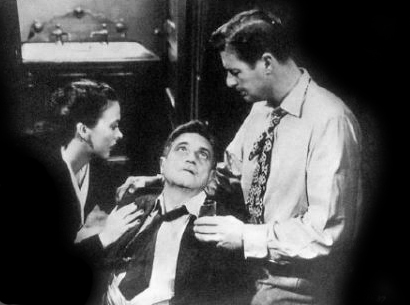
 |
|
|
|
Once again the Warner Archive Collection comes up with an obscure noir winner, in this case an all-but forgotten Allied Artists picture from 1950, when the studio was still a fancy name given to upscale Monogram pictures. Sorely lacking in star appeal, SOuthside 1-1000 is a taut gangsters vs. T-Men tale framed by some intermittently awkward storytelling. The director is Boris Ingster, a talent known to fans as the maker of what is often considered the first film noir, Stranger on the Third Floor. The hyperbolic expressionism of that 1940 film has given way to a new style that mixes shadowy night cinematography with docu-flavored location work. Producers the King Brothers had been responsible for some interesting highlights of the noir period (When Strangers Marry, Dillinger, Suspense, The Gangster) and at least one classic (Gun Crazy). SOuthside 1-1000 has enough interesting elements to keep any noir fan thoroughly engaged. 
After a stock footage prologue (removed for older TV screenings) the story proper begins when Treasury agent John Riggs (Don DeFore) joins a team investigating the source of counterfeit bills. Recognizing the handiwork of jailed forger Eugene Deane (Morris Ankrum), the experts search Deane's cell at San Quentin and find his hidden engraving tools, along with a perfect pair of plates hidden in a Bible. Allowing Deane to slip the plates out of prison, Riggs tracks the counterfeiting gang to a Los Angeles hotel. He assumes the guise of a high-rolling gambler wanted for participation in a major robbery back East, and connects with the mobsters turning out the counterfeit money. Riggs arranges to buy a large quantity of bills while simultaneously romancing his hotel manager, Nora Craig (Andrea King of Red Planet Mars), who seems tied in with the criminals. All goes well until Deane is released and rejoins the gang. If the forger recognizes Riggs as a T-Man, Riggs will be finished. SOuthside 1-1000 begins with one of the most unappetizing opening montages of the Cold War era. According to the stentorian narrator (Gerald Mohr) the real crime of the century began in WW1 -- presumably with the Russian Revolution. "The world is divided into two camps, in a fight to the death!" Now that America is engaged in a war in Korea, any weakness in our economy hurts our ability to fight the Commies. "A counterfeiter isn't just a criminal, he's a saboteur!" This may be the only American film to suggest the oft-discussed radical opinion that we "fought the wrong enemy" in WW2. After that disturbing opening the film settles into a regulation police procedural. It is possible that SOuthside 1-1000's first editorial assembly came up short, and that the political prologue was introduced as padding. The docu-like narration continues into the story proper, for a time fighting the narrative flow instead of speeding it along. But when the intrepid undercover agent Riggs lands among the counterfeiters, the movie picks up in interest. Riggs bluffs his way into winning the trust of the bad guys, helped by the support of his fellow T-Men: his fake identity checks out. As in a secret agent movie, Riggs begins an intimate relationship with Nora Craig, who withholds her full confidence -- even when she's kissing Riggs, she feels that he might be a cop. Authentic details are a big help. As soon as Riggs enters a business relationship with the gang, he's accompanied at all times by the slick thug Reggie (George Tobias). It will take a while for Riggs' cash payment to arrive, and he won't see the printing press or the fake $10 bills he's buying until the last minute. What he doesn't know is that Nora Craig has a special relationship with the elderly, sick convict Eugene Deane. Deane began as an artist and his sketchbooks include drawings of everybody that visits his cell -- including Riggs. 
The action plays out on the streets of Los Angeles, where variious unsavory characters check into hotels to conduct their business. Nora and John Riggs' first date begins on a nice note, when she meets him around the corner to avoid the rule that hotel staff shouldn't socialize with the guests. A low-key chase scene has perhaps the best use of the Angel's Flight funicular rail cars in noir, giving us good views of both ends of Bunker Hill's old landmark. The action is almost all reserved for the finish, when Riggs' fellow T-Men lose track of him just as his cover is blown in the secret press room. The exciting finale takes place in the superstructure of one of the street bridges that cross the L.A. riverbed. Boris Ingster's direction is more than competent, if unremarkable; all the previous King Bros. Noirs save for the cheap-looking Dillinger could boast interesting filming styles. But Ingster sees to it that the touchy relations among the criminals and their new associate remain interesting. Don DeFore is quite good as the agent with the tough job, even if he hasn't the distinctive presence of a Dan Duryea or Dick Powell. Viewers 'of a certain age' (cough, cough) remember DeFore as a representative of blandness, as seen in his long tenure on TV's Ozzie and Harriet Show. Andrea King avoids femme fatale clichés in her handling of the perfidious Nora, who covers every contingency yet is still undone when she allows her feminine side to come to the fore. Nora's ambivalent attitude toward Riggs continues right through the rather brutal final scene. 
Morris Ankrum's sick old convict could have used a few more scenes, as the character is fascinating. Old man Deane is a committed counterfeiter yet also an artist dedicated to his faith. The contradiction isn't really investigated, as the 'bad guys' carry off their crimes without moral qualms. The fact that the drama doesn't demonize the counterfeiters is further evidence that the Cold War prologue is a political afterthought -- none of the film's authority figures equate domestic crooks with international conspirators, as does the prologue. Among the film's many supporting actors is George Tobias, the former wisecracking Warners contract player. Tobias does a great job as a straight-faced mobster, even convincing us that he's physically imposing. Also grabbing our attention is the great actor Joe Turkel (The Killing, Paths of Glory, The Sand Pebbles, The St. Valentine's Day Massacre, The Shining, Blade Runner), already on his ninth small part just one year into his career. Turkel isn't a scene stealer, yet we're always aware of his presence. This was the first feature credit for art director - production designer Ted Haworth, who went on to top work for Alfred Hitchcock, William Wyler and Billy Wilder, as well as Don Siegel, Richard Brooks, John Frankenheimer and Sam Peckinpah. SOuthside 1-1000 is saved from the 'nowheresville' of similar low budget noirs by virtue of professionals like Haworth, who makes even dull hotel rooms seem interesting. 
The Warner Archive Collection DVD-R of SOuthside 1-1000 is a very good enhanced presentation of a film that always looked soft and washed out in old TV prints -- this is its first legit home video release despite a couple nearly unwatchable bootlegs that have cropped up in the last ten years. The opening titles look soft and may have been rescued from an alternate film source. A sprinkling of surface flecks appears here and there along with a few scratches, but otherwise the 62 year-old show is in fine visual and aural shape.
On a scale of Excellent, Good, Fair, and Poor,
SOuthside 1-1000 rates:
Reviews on the Savant main site have additional credits information and are often updated and annotated with reader input and graphics. Also, don't forget the 2011 Savant Wish List. T'was Ever Thus.
Review Staff | About DVD Talk | Newsletter Subscribe | Join DVD Talk Forum |
| ||||||||||||||||||